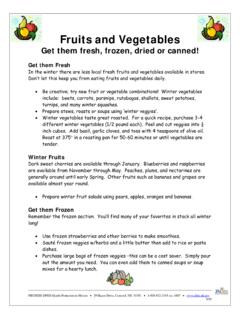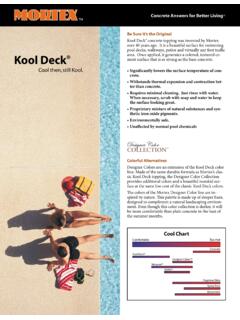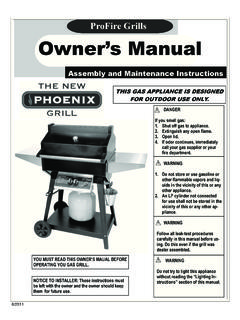Transcription of The Renal Diet
1 The Renal diet A Guide to Eating Healthier for Hemodialysis Patients 2 Table of Contents Introduction Page 3 Controlling Your Phosphorus Page 4 Controlling Your Potassium Page 5 Controlling Your Sodium Page 6 Controlling Your Protein Page 7 Controlling Your Fluid Intake Page 8 Grocery List Suggestions Page 9 Fast Food Facts for the Renal Patient Page 11 Dining Out for the Dialysis Patient Page 16 Smart Snacking Choices Page 18 Renal Friendly Holiday Food List Page 19 Cookbooks for the Kidney Patient Page 22 Renal References Page 24 Sources Cited Page 25 This information is a guide for you and your family. The purpose is to help you learn more about your health. Be sure to follow any instructions your healthcare provider gives you for your special needs. If you have any questions, or there is anything you do not understand, please ask your doctor or dietician.
2 3 Introduction Eating well is an important part of your treatment and can help you feel better. A new diet is essential part to your treatment process. Not only will it help you feel better, it can also help you avoid complications of your Renal disease such as fluid overload, high blood potassium, bone disease, and weight loss. Because every individual is different and their needs unique, the following dietary advice should be given depending on a number of factors and discussion with your Renal dietician. These factors include: stage of your Renal disease, type of treatment you are on, laboratory results, and presence of other medical conditions. Kidney function is essential for removing the waste material from food that you eat. The kidneys excrete a dietary protein called urea, as well as sodium, potassium, and phosphate. These substances can build up in the body if kidney function is impaired. Following a strict diet can lessen this accumulation and its effects.
3 Hemodialysis Patients should monitor and limit their intake of the following: Potassium Phosphate Sodium Fluids 4 Controlling Your Phosphorus Phosphorus is a mineral that healthy kidneys get rid of in the urine. In kidneys that are failing, phosphorus builds up in the blood and may cause many problems including muscle aches and pains, brittle, easily broken bones, calcification of the heart, skin, joints, and blood vessels. To keep your phosphorus levels in check, consider the following tips: 1. Limit high phosphorus foods such as: Meats, poultry, dairy and fish (you should have 1 serving of 7-8 ounces) Milk and other dairy products like cheese ( you should have one 4 oz. serving) 2. Avoid high phosphorus foods such as: Lima Beans, Black Beans, Red Beans, Black-eyed Peas, White Beans, and Garbanzo Beans Dark, whole or unrefined grains Refrigerator doughs like Pillsbury Dried vegetables and fruits Chocolate Dark colored sodas 3.
4 Don t forget to take your phosphate binders with meals and snacks. Your doctor will prescribe a medication called a phosphate binder which will be some type of polymer gel or calcium medication. You need to take your phosphate binder as prescribed by your doctor. Often you will take a phosphate binder with every meal and snack. 4. Usually your diet is limited to 1000 mg of phosphorus per day. 5 Controlling Your Potassium Potassium is an element that is necessary for the body to keep a normal water balance between the cells and body fluids. All foods contain some potassium, but some contain larger amounts. Normal kidney function will remove potassium through urination. Kidneys that are not functioning properly cannot remove the potassium in the urine, so it builds up in the blood. This can be very dangerous to your heart. High potassium can cause irregular heart beats and can even cause the heart to stop if the potassium levels get to high.
5 Typically, there are no symptoms for someone with a high potassium level. If you are concerned about your potassium level, check with your doctor, and follow the tips below. Usually a Renal patient s diet should be limited to 2000 mg of potassium each day. The following foods are high in potassium: Bananas Avocado Oranges Orange Juice Prunes Prune Juice Tomatoes Tomato Juice Tomato Sauce Cantaloupe Tomato Puree Honeydew Melon Nuts Papaya Chocolate Red Beans Milk White Beans Lima Beans Garbanzo Beans Black Beans Lentils Split peas Baked Beans Specially Prepared Potatoes: 1. Peel and slice into 1/8 inch pieces. 2. Soak 1 cup potatoes in 5 cups of water for 2 hours. 3. Drain and rinse and drain. 4. Cook in a large amount of water. 5. Drain and mash, fry or serve plain. 6 Controlling Your Sodium Sodium, or sodium chloride, is an element that is used by all living creatures to regulate the water content in the body.
6 Usually a sodium restriction comes in the form of No Added Salt. This is necessary because a greater intake of sodium will result in poorly controlled blood pressure and excessive thirst which can lead to difficulty adhering to the fluid restrictions in your diet . To limit your sodium, you should: Avoid table salt and any seasonings that end with the word salt Avoid salt substitutes (they contain potassium) Avoid salty meats such as bacon, ham, sausage, hot dogs, lunch meats, canned meats, or bologna Avoid salty snacks such as cheese curls, salted crackers, nuts, and chips Avoid canned soups, frozen dinners, and instant noodles Avoid bottled sauces, pickles, olives, and MSG 7 Controlling Your Protein Protein is important to aid in growth and maintenance of body tissue. Protein also plays a role in fighting infection, healing of wounds, and provides a source of energy to the body.
7 You should make sure to eat 7-8 ounces of protein every day. Foods that are high in protein include beef, pork, veal, chicken, turkey, fish, seafood, and eggs. 1 egg is equal to 1 ounce of protein, and three ounces of protein is comparable to the size of a deck of cards. 8 Controlling Your Fluid Intake People on dialysis often have decreased urine output, so increased fluid in the body can put unnecessary pressure on the person s heart and lungs. A fluid allowance for individual patients is calculated on the basis of urine plus 500ml. The 500 ml covers the loss of fluids through the skin and lungs. Most patients will not urinate as much once they begin Hemodialysis. Those who produce a lot of urine may be able to drink more than those who do not produce urine. Between each dialysis treatment, patients are expected to gain a little weight due to the water content in foods (fruits and vegetables).
8 The amount of fluid in a typical day s meal (excluding fluids such as water, tea, etc.) is at least 500 ml and therefore expected daily weight gain is between To control fluid intake, patients should: Not drink more than what your doctor orders (usually 4 cups of fluid each day) Count all foods that will melt at room temperature (Jell-O , popsicles, and fruit ices). 9 Grocery List Suggestions Meat/Protein Foods Vegetables Breads/Cereals/Grains Beverages Beef Chicken (Serving size= cup, no added salt) Bagels (plain, blueberry, egg, raisin) (Keep in mind your fluid restriction) (Diabetics- use Egg Substitute Alfalfa Sprouts Bread (white, French Caution for sugar intake) Egg Beaters , Scramblers Arugula Italian, rye, soft wheat) (Regular or diet ) Eggs Asparagus Bread sticks (plain) 7-Up Fish Bean Sprouts Cereals, dry, low-salt Cherry 7-Up Lamb Beets (canned) (Corn Pops , Cocoa Cream Soda Pork (chops, roast) Cabbage (green, red) Puffs , Sugar Smacks , Ginger Ale Shellfish carrots Fruity Pebbles , Puffed Grape Soda Tofu Cauliflower Wheat , Puffed Rice ) Lemon-Lime Soda Tuna (canned)
9 Celery Cereals, cooked Mellow Yellow Turkey Chayote (Cream of Rice or Mountain Dew Veal Chili Peppers Wheat , Farina , Orange Soda Wild Game Chives Malt-o-Meal ) Root Beer Coleslaw Couscous Slice Fruits Corn Crackers (unsalted) Sprite (Serving size= 1 medium-size fruit or cup canned, no added sugar) Cucumber Eggplant Endive Dinner Rolls or Hard Rolls English Muffins Coffee Fruit Punch Hi-C (cherry, grape) Apple Juice Garlic Grits Horchata Apples Gingerroot Hamburger/Hotdog Bun Juices (apple, Applesauce Green Beans Macaroni cranberry, grape) Apricot Nectar Hominy Melba Toast Kool-Aid Apricots (canned) Jalapenos (fresh) Noodles Lemonade Blackberries Kale Oyster Crackers Limeade Cherries Leeks Pita Bread Mineral Water Cranberries Lettuce Popcorn (unsalted) Nectars (apricot, Cranberry Juice Mixed Vegetables Pretzels (unsalted) peach, pear, cup Cranberry Sauce Mushrooms Rice (brown, white) serving) Figs (fresh) Onions Rice Cakes Nondairy Creamers Fruit Cocktail Parsley Spaghetti (Coffee Rich, Grapefruit Peas (English) Tortillas Mocha Mix , etc.)
10 Grape Juice Pimentos Sunny Delight Grapes Radicchio Tea Lemon Radishes Dairy/Dairy Substitutes Lemon Juice Seaweed Kelp Nondairy Creams Lime Spaghetti Squash Nondairy Frozen Dessert Fats Lime Juice Loganberries Summer squash (scallop, Topping (Cool Whip ) Nondairy Frozen Dessert Butter Cream Cheese Lychees Peach (canned) crookneck, straightneck, (Mocha Mix ) Rice Milk (unfortified) Margarine Mayonnaise Peach Nectar zucchini) Miracle Whip Pear Nectar Sweet Peppers Nondairy Creamers Pears (canned) Tomatillos Salad Dressings Pineapple Turnips Sour Cream Plums Turnip Greens Vegetable Oils Raspberries Water Chestnuts (preferably canola Strawberries Watercress or olive oil) Tangerines Yambean (jicama), cooked 10 Grocery List Suggestions Seasonings and Spices Desserts/Snacks/Sweets Notes Allspice (Diabetics - use caution) _____ Basil Animal Crackers Bay Leaf Cake (angel food, butter, _____ Caraway Sead lemon, pound, spice, Chives strawberry, white, yellow) _____ Cilantro Candy Corn Cinnamon Chewing Gum _____ Cloves Cinnamon Drops Cumin Cookies (ginger snaps, _____ Curry shortbread, sugar, dill vanilla wafers) _____ Extracts (almond, lemon Corn Cakes lime, maple, orange, Cotton Candy _____ peppermint, vanilla, Doughnuts walnut) Fruit Ice _____ Fennel Graham Crackers Garlic Powder Gumdrops _____ Ginger Gummy Bears Horseradish (root) Hard Candy _____ Lemon Juice Hot Tamale Candy Mrs.










